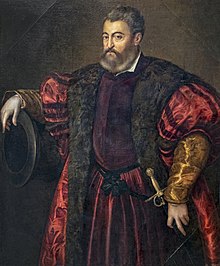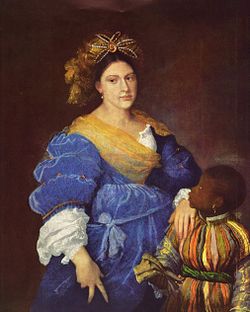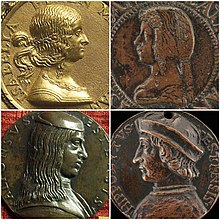
Alfonso I d'Este

| Alfonso d'Este | |
|---|---|
 Alfonso by Titian; Alfonso leans on a cannon, holding his sword | |
| Duke of Ferrara Duke of Modena and Reggio | |
| Reign | 25 January 1505 – 31 October 1534 |
| Predecessor | Ercole I d’Este |
| Successor | Ercole II d'Este |
| Born | 21 July 1476 Subiaco, Papal States |
| Died | 31 October 1534 (aged 58) Ferrara, Duchy of Ferrara |
| Spouse | Anna Sforza (m. 1491; died 1497) Lucrezia Borgia (m. 1501; died 1519) Laura Dianti (m. 1534)[a] |
| Issue Detail | Ercole II d'Este, Duke of Ferrara Ippolito II d'Este Leonora d'Este Francesco d'Este, Marchese di Massalombarda Alfonso d'Este, Lord of Montecchio (illegitimate, father of Cesare d'Este) |
| House | Este |
| Father | Ercole I d'Este |
| Mother | Eleanor of Naples |
Alfonso d'Este (21 July 1476 – 31 October 1534) was Duke of Ferrara from 1504 to 1534, during the time of the War of the League of Cambrai.

Biography



He was the son of Ercole I d'Este, Duke of Ferrara and Eleanor of Naples and became duke on Ercole's death in January 1505. In the first year of his rule he uncovered a plot by his brother Ferrante and half-brother Giulio d'Este, directed against him and his other brother Ippolito.[3] In September 1506 a trial for lèse majesté and high treason was held and, as expected, the death sentence was passed, but just as Ferrante and Giulio were about to mount the gallows they were informed that the duke had commuted their sentence to life imprisonment. They were led away to two cells in the Torre dei Leoni. Ferrante died in his cell after 34 years of imprisonment, while Giulio held on until he was pardoned in 1559, after 53 years of imprisonment. After his release, Giulio was ridiculed in the streets of Ferrara for his outdated clothes and died in 1561.

In the Italian Wars Alfonso preserved his precarious position among the contending powers by flexibility and vigilance and the unrivalled fortifications of Ferrara; he entered the League of Cambrai against Venice and remained an ally of Louis XII of France even after Pope Julius II had made peace with Venice; when the Bolognesi rebelled against Julius and toppled Michelangelo's bronze statue of the Pope from above the gate, Alfonso received the shards and recast them as a cannon named La Giulia, which he set on the ramparts of the castello: in 1510 Julius excommunicated him and declared his fiefs forfeit, thereby adding Ferrara to the Papal States; Alfonso then fought successfully against the Venetian and Papal armies, winning the Battle of Polesella, capturing Bologna, and playing a major part in the French victory at the Battle of Ravenna (1512). These successes were based on Ferrara's artillery, produced in his own foundry, which was the best of its time.[4][5] In both of his portraits by Titian, (Compare illustration above) he poses with his arm across the mouth of one of his cannon.


In 1526–1527 Alfonso participated in the expedition of Charles V, Holy Roman Emperor and king of Spain, against Pope Clement VII, and in 1530 the pope again recognized him as possessor of the forfeited duchies of Modena and Reggio.

Marriages and issue
In January 1491, Alfonso married Anna Maria Sforza, the niece of Ludovico Sforza, Duke of Milan. In the same ceremony, Ludovico married Alfonso's younger sister, Beatrice d'Este, the double wedding orchestrated by Leonardo da Vinci.

Politically, the wedding was designed to cement ties between the two families. Anna Sforza's death on 30 November 1497 marked the end of those ties, as Beatrice d'Este had died in January of that same year.

In 1501, Alfonso married Lucrezia Borgia. Their children were:

- A stillborn daughter (1502);
- Alessandro d'Este (1505–1505);
- Ercole II d'Este, Duke of Ferrara (5 April 1508 – 3 October 1559);
- Ippolito II d'Este (25 August 1509 – 1 December 1572). Archbishop of Milan and later Cardinal;
- Alessandro d'Este (1514–1516);
- Leonora d'Este (3 July 1515 – 15 July 1575), a nun and composer;
- Francesco d'Este, Marquess of Massalombarda (1 November 1516 – 2 February 1578);
- Isabella Maria d'Este (born and died on 14 June 1519).[6]
After Lucrezia's death on 24 June 1519, he married Laura Dianti by whom he had had two illegitimate sons (later legitimized), Alfonso and Alfonsino d'Este.

Art


Like his brother Ippolito I, Cardinal d'Este, he was one of the great patrons of art of his time: for him the elderly Giovanni Bellini painted The Feast of the Gods in 1514, Bellini's last completed painting. He turned to Bellini's pupil, Titian, for a sequence of paintings. In 1529 Alfonso created the most magnificent gallery of his time, his studiolo or camerino d'alabastro ("small alabaster room"), now usually known as his "Camerino", in order to better display his works of art against white marble-veneered walls under a gilded ceiling.[7] The pallor of the marble led to the name of this room as the chamber of alabaster. There are documents from Mario Equicola on 9 October 1511, noting plans for painting of a room in Ferrara, in which six fables (fabule) or histories (istorie) shall be placed. I have already found them and have presented them in writing." A letter from Alfonso, dated 14 November 1514, authorized payment to Giovanni Bellini, the first painting completed for the chamber. Titian is known to have painted two portraits of Alfonso: the first was widely acclaimed, singled out by Michelangelo and coerced as a diplomatic gift by Charles V, Holy Roman Emperor; Alfonso induced Titian to paint a free replica, which the artist of the painting illustrated above has adapted for his model.[8] Over the next two decades, Titian added three more paintings: The Worship of Venus (Museo del Prado, Madrid), The Bacchanal of the Andrians (Prado, Madrid), and Bacchus and Ariadne (National Gallery, London). Dosso Dossi produced another large bacchanal, and he also contributed ceiling decorations and a painted frieze for the cornice, depicting scenes from the Aeneid, which gained immediacy by showing the heroes in contemporary dress (illustration, left). All the bacchanals in the Alabaster Chamber dealt with love, and some refer to marriage. After the Este family lost control of Ferrara in 1598, the Alabaster Chamber's paintings and sculptures were dispersed.

-
The Feast of the Gods by Giovanni Bellini and Titian
-
The Worship of Venus by Titan
-
Bacchanal of the Andrians by Titian
-
Bacchus and Ariadne by Titan
-
Aeneas and Achates on the Libyan shore, painted by Dosso Dossi for Alfonso's camerino d'alabastro (National Gallery of Art, Washington).
-
Trimph of Baccus by Dosso Dossi for Alfonso's camerino d'alabastro'
Alfonso inherited from Cardinal d'Este the poet Ariosto. Following in the lead of his father Ercole, who had made Ferrara into one of the musical centres of Europe, Alfonso brought some of the most famous musicians of the time to his court to work as composers, instrumentalists and singers. Musicians from northern Europe who worked at Ferrara during his reign included Antoine Brumel and Adrian Willaert, the latter of whom was to become the founder of the Venetian School, something which could not have happened without Alfonso's patronage.

History
When Alfonso's grandson Alfonso II d'Este—Robert Browning's duke of "My Last Duchess"[9]—produced no male heir, the main d'Este line died out. A grandson of Alfonso I and cousin of Alfonso II, Cesare d'Este had been born out of wedlock. He was recognized by the Emperor but not by the Pope, who took the Duchy of Ferrara by force. Nevertheless, the House of Este continued in Modena and Reggio.

Ancestors
| 8. Alberto d'Este, Marquis of Ferrara | |||||||||||||||
| 4. Niccolò III d'Este, Marquis of Ferrara | |||||||||||||||
| 9. Isotta Albaresani | |||||||||||||||
| 2. Ercole I d'Este, Duke of Ferrara | |||||||||||||||
| 10. Thomas III, Marquis of Saluzzo | |||||||||||||||
| 5. Ricciarda, Marquise of Saluzzo | |||||||||||||||
| 11. Marguerite de Pierrepont | |||||||||||||||
| 1. Alfonso I d'Este, Duke of Ferrara | |||||||||||||||
| 12. Alfonso V of Aragon | |||||||||||||||
| 6. Ferdinand I of Naples | |||||||||||||||
| 13. Giraldona Carlino | |||||||||||||||
| 3. Eleanor of Naples | |||||||||||||||
| 14. Tristan, Count of Copertino | |||||||||||||||
| 7. Isabella of Clermont | |||||||||||||||
| 15. Caterina del Balzo Orsini | |||||||||||||||
See also
Notes
- ^ The marriage between Alfonso I and Laura Dianti probably took place shortly before the Duke's death in 1534.[1] The historian Muratori tried to prove that the marriage had taken place, collecting a considerable amount of documentation,[2] but there does not seem to be any official document of a marriage that actually took place. Even in the absence of absolute documentary proof, "there can be no doubts about the public, official nature of the union".[2]
References
- ^ Bertoni, Luisa. "ESTE, Alfonso d' | Dizionario Biografico degli Italiani - Volume 43 (1993)". www.treccani.it (in Italian). Retrieved 26 June 2023.
- ^ a b Pellizzer Sonia. "DIANTI, Laura | Dizionario Biografico degli Italiani - Volume 39 (1991)". www.treccani.it (in Italian). Retrieved 26 June 2023.
- ^ "House of Este | Italian Renaissance, Politics & Art | Britannica". www.britannica.com. Retrieved 1 October 2023.
- ^ Murrin, Michael (1994). History and warfare in Renaissance epic (Pbk. ed.). Chicago: University of Chicago Press. pp. 124–125. ISBN 978-0226554037.
- ^ Mallett, Michael; Shaw, Christine (2005). The Italian Wars, 1494–1559 : War, State and Society in Early Modern Europe (1st ed.). Harlow: Pearson. p. 107. ISBN 978-0582057586.
- ^ Gregorovius, Ferdinand (14 August 2012). Lucrezia Borgia. dearbooks. in Europäischer Literaturverlag GmbH. p. 292. ISBN 9783954554195.
- ^ "Reconstructing the Duke's private gallery". www.webexhibits.org.
- ^ Bryson Burroughs, "The Portrait of Alfonso d'Este by Titian" The Metropolitan Museum of Art Bulletin 22.4 (April 1927), pp. 97–101.
- ^ "Browning's Portrait of a Renaissance Man: Alphonso II D' este, Duke of Ferrara, in "My Last Duchess" (1842)". Archived from the original on 29 September 2005. Retrieved 6 July 2005.
Bibliography
- Taylor, Frederick Lewis (1973). The Art of War in Italy, 1494–1529. Westport: Greenwood Press. ISBN 0-8371-5025-6.
- Prignano, Gaia (2020). "Music Theories and Identity Issues: Depicting Canons chez Alfonso I d'Este". Music in Art: International Journal for Music Iconography. 45 (1–2): 53–71. ISSN 1522-7464.
External links
![]() Media related to Alfonso I d'Este, Duke of Ferrara at Wikimedia Commons
Media related to Alfonso I d'Este, Duke of Ferrara at Wikimedia Commons

- Dosso Dossi: Court Painter in Renaissance Ferrara, a full text exhibition catalog from The Metropolitan Museum of Art
- "Alfonso d'Este, Duke of Ferrara"
- "Reconstructing the Duke's private gallery"

- 1476 births
- 1534 deaths
- House of Este
- Dukes of Ferrara
- Dukes of Modena
- Dukes of Reggio
- Foundrymen
- Military leaders of the Italian Wars
- People excommunicated by the Catholic Church
- 15th-century Italian nobility
- 16th-century Italian nobility
- Burials at the Corpus Domini Monastery, Ferrara
- Husbands of Lucrezia Borgia
- People of the Italian Wars
See what we do next...
OR
By submitting your email or phone number, you're giving mschf permission to send you email and/or recurring marketing texts. Data rates may apply. Text stop to cancel, help for help.
Success: You're subscribed now !






